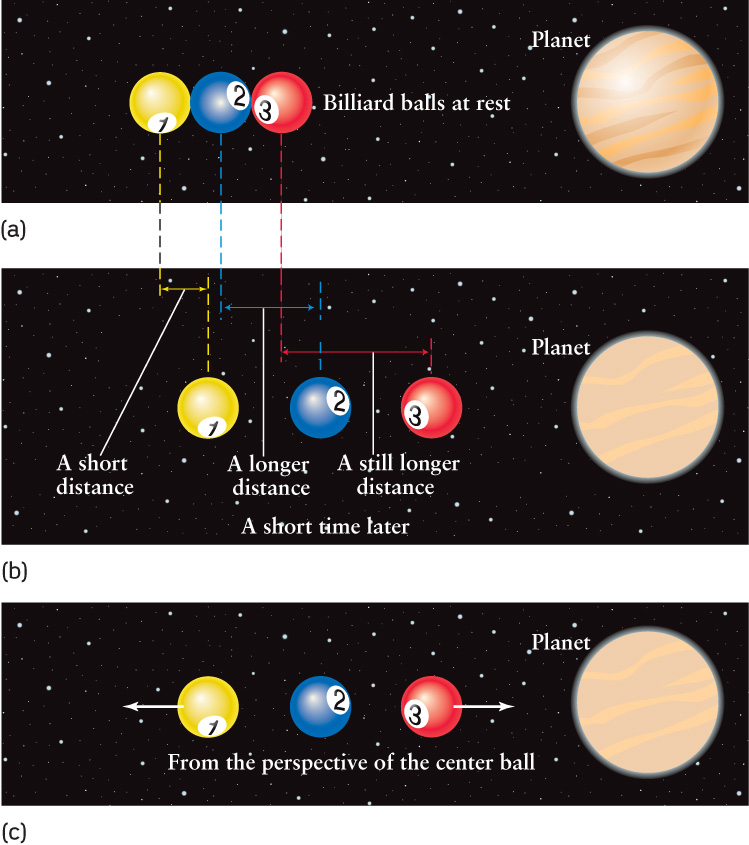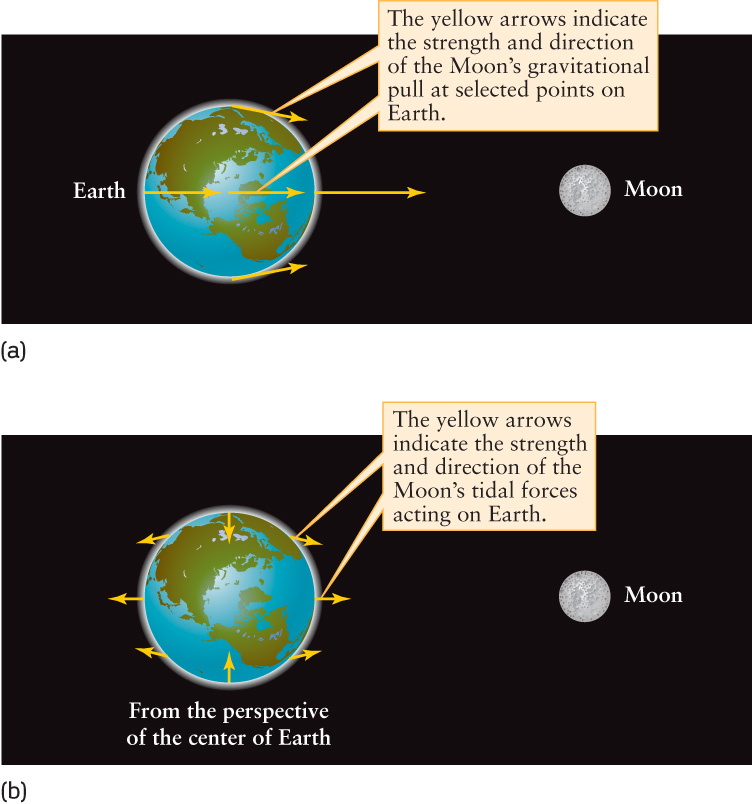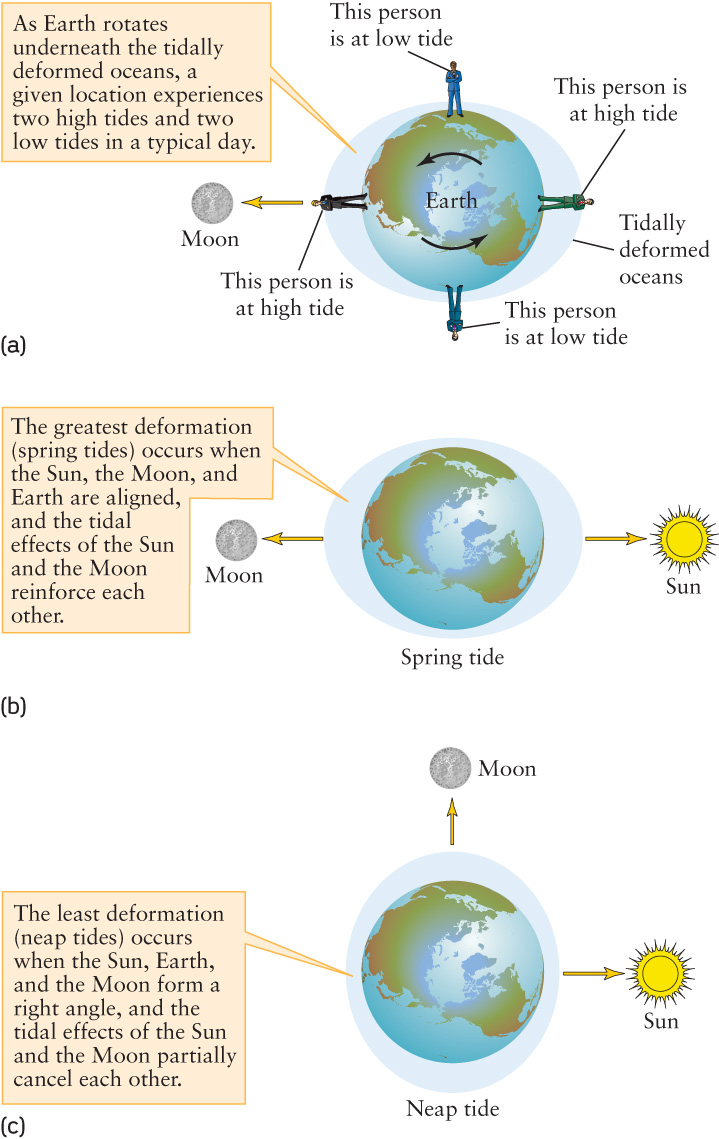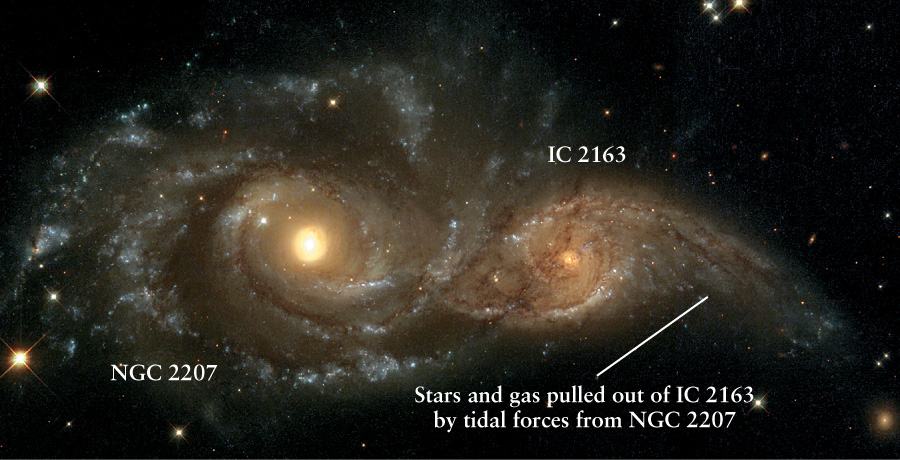4-8 Gravitational forces between Earth and the Moon produce tides
Tidal forces reveal how gravitation can pull objects apart rather than drawing them together
We have seen how Newtonian mechanics explains why the Moon stays in orbit around Earth. It also explains why there are ocean tides, as well as why the Moon always keeps the same face toward Earth. Both of these are the result of tidal forces—a consequence of gravity that deforms planets and reshapes galaxies.
Tidal forces are differences in the gravitational pull at different points in an object. As an illustration, imagine that three billiard balls are lined up in space at some distance from a planet, as in Figure 4-26a. According to Newton’s law of universal gravitation, the force of attraction between two objects is greater the closer the two objects are to each other. Thus, the planet exerts more force on the 3-ball (in red) than on the 2-ball (in blue) and exerts more force on the 2-ball than on the 1-ball (in yellow). Now, imagine that the three balls are released and allowed to fall toward the planet. Figure 4-26b shows the situation a short time later. Because of the differences in gravitational pull, a short time later the 3-ball will have moved farther than the 2-ball, which will in turn have moved farther than the 1-ball. But now imagine that same motion from the perspective of the 2-ball. From this perspective, it appears as though the 3-ball is pulled toward the planet while the 1-ball is pushed away (Figure 4-26c). These apparent pushes and pulls are called tidal forces.

 The Origin of Tidal Forces (a) Imagine three identical billiard balls placed some distance from a planet and released. (b) The closer a ball is to the planet, the more gravitational force the planet exerts on it. Thus, a short time after the balls are released, the blue 2-ball has moved farther toward the planet than the yellow 1-ball, and the red 3-ball has moved farther still. (c) From the perspective of the 2-ball in the center, it appears that forces have pushed the 1-ball away from the planet and pulled the 3-ball toward the planet. These forces are called tidal forces.
The Origin of Tidal Forces (a) Imagine three identical billiard balls placed some distance from a planet and released. (b) The closer a ball is to the planet, the more gravitational force the planet exerts on it. Thus, a short time after the balls are released, the blue 2-ball has moved farther toward the planet than the yellow 1-ball, and the red 3-ball has moved farther still. (c) From the perspective of the 2-ball in the center, it appears that forces have pushed the 1-ball away from the planet and pulled the 3-ball toward the planet. These forces are called tidal forces.
Tidal Forces on Earth
The Moon has a similar effect on Earth as the planet in Figure 4-26 has on the three billiard balls. The arrows in Figure 4-27a indicate the strength and direction of the gravitational force of the Moon at several locations on Earth. The side of Earth closest to the Moon feels a greater gravitational pull than does Earth’s center, and the side of Earth that faces away from the Moon feels less gravitational pull than does Earth’s center. This means that just as for the billiard balls in Figure 4-26, there are tidal forces acting on Earth (Figure 4-27b). These tidal forces exerted by the Moon try to elongate Earth along a line connecting the centers of Earth and the Moon and try to squeeze Earth inward in the direction perpendicular to that line.

Because the body of Earth is largely rigid, it cannot deform very much in response to the tidal forces of the Moon. But the water in the oceans can and does deform into a football shape, as Figure 4-28a shows. As Earth rotates, a point on its surface goes from where the water is shallow to where the water is deep and back again. This is the origin of low and high ocean tides. (In this simplified description we have assumed that Earth is completely covered with water. The full story of the tides is much more complex, because the shapes of the continents and the effects of winds must also be taken into account.)

The Sun also exerts tidal forces on Earth’s oceans. (The tidal effects of the Sun are about half as great as those of the Moon.) When the Sun, the Moon, and Earth are aligned, which happens at either new moon or full moon, the tidal effects of the Sun and Moon reinforce each other and the tidal distortion of the oceans is greatest. This produces large shifts in water level called spring tides (Figure 4-28b). At first quarter and last quarter, when the Sun and Moon form a right angle with Earth, the tidal effects of the Sun and Moon partially cancel each other. Hence, the tidal distortion of the oceans is the least pronounced, producing smaller tidal shifts called neap tides (Figure 4-28c).
CAUTION!
Note that spring tides have nothing to do with the season of the year called spring. Instead, the name refers to the way that the ocean level “springs up” to a greater than normal height. Spring tides occur whenever there is a new moon or full moon, no matter what the season of the year.
Tidal Forces on the Moon and Beyond
Just as the Moon exerts tidal forces on Earth, Earth exerts tidal forces on the Moon. Soon after the Moon formed some 4.56 billion years ago, it was molten throughout its volume. Earth’s tidal forces deformed the molten Moon into a slightly elongated shape, with the long axis of the Moon pointed toward Earth. The Moon retained this shape and orientation when it cooled and solidified. To keep its long axis pointed toward Earth, the Moon spins once on its axis as it makes one orbit around Earth—that is, it is in synchronous rotation (Section 3-2). Hence, the same side of the Moon always faces Earth, and this is the side that we see. For the same reason, most of the satellites in the solar system are in synchronous rotation, and thus always keep the same side facing their planet.
Tidal forces are also important on scales much larger than the solar system. Figure 4-29 shows two spiral galaxies, like the one in Figure 1-9, undergoing a near-collision. During the millions of years that this close encounter has been taking place, the tidal forces of the larger galaxy have pulled an immense streamer of stars and interstellar gas out of the smaller galaxy.

Tidal Forces on a Galaxy For millions of years the galaxies NGC 2207 and IC 2163 have been moving ponderously past each other. The larger galaxy’s tremendous tidal forces have drawn a streamer of material a hundred thousand light-years long out of IC 2163. If you lived on a planet orbiting a star within this streamer, you would have a magnificent view of both galaxies. NGC 2207 and IC 2163 are, respectively, 143,000 light-years and 101,000 light-years in diameter. Both galaxies are 114 million light-years away in the constellation Canis Major.
Many galaxies, including our own Milky Way Galaxy, show signs of having been disturbed at some time by tidal interactions with other galaxies. By their effect on the interstellar gas from which stars are formed, tidal interactions can actually trigger the birth of new stars. Our own Sun and solar system may have been formed as a result of tidal interactions of this kind. Hence, we may owe our very existence to tidal forces. In this and many other ways, the laws of motion and of universal gravitation shape our universe and our destinies.